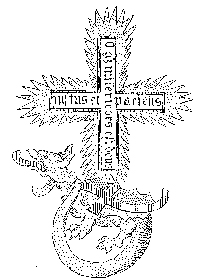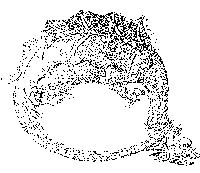The Order of the Dragon (German "Drachenorden" and Latin "Societatis draconistrarum") was an institution, similar to other chivalric orders of the time, modelled on the Order of St George (1318). It was created in 1408 by the Holy Roman Emperor Sigismund (while he was still king of Hungary) and his queen Barbara Cilli, mainly for the purpose of gaining protection for the royal family. According to its statute (which survives in a copy dated 1707), the Order also required its initiates to defend the Cross and to do battle against its enemies, principally the Turks. The original Order comprised twenty-four members of the nobility, including such notable figures as King Alfonso of Aragon and Naples, and Stefan Lazarevic of Serbia.
In 1431, Sigismund summoned to the city of Nuremberg a number of princes and vassals that he considered useful for both political and military alliances. His primary objective was to initiate the group into the Order of the Dragon. One of these was Vlad (father of Vlad the Impaler), a claimant for the throne of the principality of Wallachia (now part of modern Romania), who was at the time serving in Sighisoara as frontier commander guarding the mountain passes from Transylvania into Wallachia from enemy incursion. While at Nuremberg, Vlad also received Sigismund's pledge to support his claim to the throne of Wallachia. But it would be another five years before that ambition could be realized.
The Order of the Dragon adopted as its symbol in 1408 the image of a circular dragon with its tail coiled around its neck. On its back, from the base of its neck to its tail, was the red cross of St George on the background of a silver field. With the expansion of the Order, other symbols were adopted, all variations on the theme of dragon and cross. For example, one class of the Order used a dragon being strangled with a cross draped across its back; another presents a cross perpendicular to a coiled-up dragon with an inscription "O quam misericors est Deus" (vertical) and "Justus et paciens" (horizontal). Other emblems of the Order included a necklace and a seal, each with a variant form of the dragon motif.
Variant Emblems of the Order of the Dragon


(Click on pictures to see larger image)
Vlad was obviously proud of this achievement. Later he had coins minted which show on one side a winged dragon. His personal coat-of-arms also incorporated a dragon. In all of these cases, the dragon was intended to convey a favourable image drawn from medieval iconography in which the dragon represents the Beast of Revelation (Satan) who is slain by the forces of good (Christianity). Vlad took on the nickname "Dracul" in reference to his induction into the order. The word "dracul" has its origins in the Latin "draco" meaning "the dragon".
His son Vlad (better known as Vlad the Impaler) used the sobriquet "Dracula"in the context of "son of Dracul" or "son of he who was a member of the Order of the Dragon". Once again it was used as a term of honour. On a number of occasions, Vlad (the Impaler) signed documents using the name. The word "dracul", however, took on a second meaning ("the devil") which was applied to members of the Dracula family by their enemies and possibly also by superstitious peasants. It was this second meaning that found its way into William Wilkinson's An Account of the Principalities of Wallachia and Moldavia (1820), the book in which Bram Stoker found the name "Dracula". There is no evidence whatsoever that Stoker knew about the Order of the Dragon.
After the death of Sigismund in 1437, the Order of the Dragon lost much of its prominence, though its iconography was retained on the coats-of-arms of several noble families.
For further information on the Order of the Dragon:
Radu Florescu & Raymond McNally, Dracula: Prince of Many Faces (Boston: Little, Brown, 1989), pp 40-42.
Constantin Rezachevici, "From the Order of the Dragon to Dracula." Journal of Dracula Studies (Number 1, 1999), pp 3-7.
|

